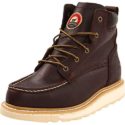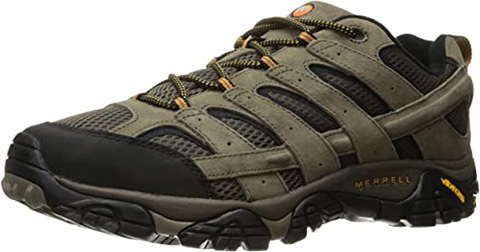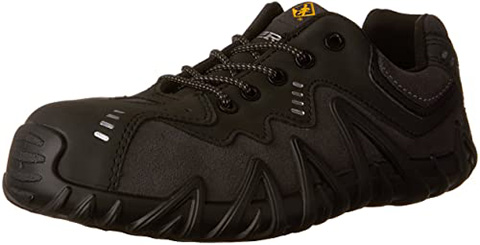10 Best Shoes for Roofing in 2024 – Reviews & Top Picks
-
- Last updated:


Roofing shoes are an important part of the job and will require serious consideration to keep you comfortable and safe. Shoes can have several features that you may like or may make a shoe uncomfortable for you. Working on a roof can put your foot at many strange angles, and there are many dangers as well.
We’ve chosen ten different brands to review for you to help you find a brand that’s safe and comfortable. We’ve also included a buyer’s guide where we discuss what makes one roofing shoe better than another, so you know what to look for when you shop.
Join us while we discuss slip resistance, durability, break-in period, and more to help you make an informed purchase.

A Quick Comparison of Our Favorites in 2024:
| Rating | Image | Product | Details | |
|---|---|---|---|---|
Best Overall
 |
 |
ROCKROOSTER Work Boots |
|
CHECK PRICE |
Best Value
 |
 |
TICCOON Work Steel Toe Shoes |
|
CHECK PRICE |
Premium Choice
 |
 |
Irish Setter Men’s 83605 Work Roofing Boot |
|
CHECK PRICE |
|
|
 |
Thorogood Men’s American Roofer Boots |
|
CHECK PRICE |
|
|
 |
EVER BOOTS Waterproof Work Boots |
|
CHECK PRICE |
The 10 Best Shoes for Roofing:
1. ROCKROOSTER Roofing Work Boots – Best Overall

The ROCKROOSTER Work Boots are our pick for the best shoes for roofing overall. These boots use full grain tumbled leather and COOLMAX performance fabric in its construction. COOLMAX technology moves sweat away from the foot and through the fabric where it can evaporate, and a dual-density shock-absorbing footbed massages as you work. It features a steel toecap that’s widened to allow the foot more room. These boots are waterproof and anti-slip and feature several other safety features, including puncture resistance, anti-electrical, anti-fatigue, and oil-resistant properties. The Goodyear welt allows you to replace the sole when it wears down.
The only real downside to ROCKROOSTER was that they are heavy at close to 5 pounds and can take some getting used to if you are not used to steel-toe boots.
- Full grain tumbled leather and COOLMAX performance fabric
- Steel toecap
- Goodyear welt
- Dual-density shock-absorbing footbed
- Waterproof
- Anti-slip
- Multiple safety features
- Heavy
2. TICCOON Work Steel Toe Shoes – Best Value

TICCOON Work Steel Toe Shoes are our pick as the best shoes for roofing for the money. These shoes are lightweight at 2.35 pounds, and the rubber soles grip surfaces well and protect you from electricity. The fabric breathes, so your feet stay cool, and it’s durable enough to handle the hard work.
The only real problem we had with TICCOON shoe is that they are not steel-toe or puncture-proof.
- Non-slip
- Water-resistant
- Rubber soles
- 35 pounds
- Breathable
- No-steel toe
3. Irish Setter Men’s 83605 Work Roofing Boot – Premium Choice

The Irish Setter Men’s 83605 Work Roofing Boot is our premium choice pick for roofing shoes. These work boots are 100% leather and feature a rubber sole that provides amazing grip and protection from electrical hazards. The soul reaches 1.5 inches thick at the sole, and the entire shoe is heat resistant. These boots support your ankles, and at 1.56 pounds, they won’t weigh you down.
While we found these boots one of the most comfortable on this list, part of the reason the Irish Setter Men’s 83605 are so light is that the fabric is quite thin and doesn’t supply any protection from nail or staple guns. After spending a few days working on our knees, our toes began to bust through the seam.
- 100% leather
- Rubber soul
- 5” thick heel
- Heat resistant
- Ankle support
- 56 lbs
- Not steel toe
- Toe seam not durable
Find a roofing specialist in your area, and get free, no-commitment estimates for your project.Consult a Roofing expert

4. Thorogood Men’s American Roofer Boots

The Thorogood Men’s American Roofer Boots are 100% leather and feature a polyurethane MAXWear Wedge sole. The sole is 1¼-inch thick at the heel, providing plenty of grip and protection from electricity. They are also oil-resistant and lightweight at only 1.9 pounds.
The Thorogoods will put you through a rough break-in period that almost made us give up on this brand, but they suddenly became quite comfortable. The laces are hard to keep tied, and there’s no steel toe to protect you from staples.
- 100% leather
- Polyurethane MAXWear Wedge sole
- Anti-slip
- Oil-resistant
- Shock resistant
- 9 lbs
- Painful break-in period
- Laces do not stay tight
5. EVER BOOTS Waterproof Work Boots

The EVER BOOTS Waterproof Work Boots are 100% leather and feature a rubber sole. A special soft leather doesn’t require a break-in period, so you can wear them on the job at once. The insole is removable so you can use a third-party one if it suits your feet better, and a steel shank protects the boot and your foot when walking down ladders or stairs. They are waterproof and oil, slip, and scratch-resistant.
The EVER BOOTS have very flimsy lace hooks, and eyelets and ours began falling off after just a few weeks. We also felt they were a little narrow for the foot, and they were borderline heavy at three or more pounds.
- 100% leather
- Rubber sole
- No break-in
- Removable insole
- Oil, slip, and abrasion-resistant
- Steel shank
- Waterproof
- Over three pounds
- Flimsy lace hooks
- Narrow
6. Merrell Men’s Moab 2 Vent Hiking Shoe

The Merrell Men’s Moab 2 Vent Hiking Shoe features a suede leather mesh outer fabric that is both breathable and durable. It has a unique closed-cell foam tongue that helps keep dirt and moisture from entering the shoe, and a protective rubber toecap helps protect your toes from stubs and staples. The synthetic soles are slip-resistant on all surfaces and provide stability.
Some of the things we didn’t like about the Merrell Men’s Moab 2 was its flimsy eye loops that snapped after a few weeks. These are squeaky shoes, and one or both makes noise with every step, and the vent holes under the heel may be well-intentioned, but it grates at your heel and is uncomfortable after a long day. Luckily, the insoles are removable so you can put new ones in and fix them. The last problem we had with this brand was high arches. If you have problems with your feet, you may find the arches in these shoes too high for comfort.
- Suede leather mesh
- Closed-cell foam tongue
- Protective rubber toecap
- Durable
- Slip-resistant
- Flimsy eye loops
- Vent holes under the balls of your feet
- Squeak
- High arches
7. Wolverine Men’s Floorhand Work Shoe

The Wolverine Men’s Floorhand Work Shoe is 100% leather with a thick rubber sole. They have a steel toe to protect you from stubs, staples, nails, and other hazards, and the cushioned footbed is comfortable to stand on for extended periods.
Unfortunately, the Wolverines are not very durable and started to show serious signs of wear after just a few weeks of light use. The sizing is also off, and our shoes were a little big.
- 100% Leather
- Rubber sole
- Waterproof
- Cushioned footbed
- 9 pounds
- Steel toe
- Not very durable
- Oversized
8. Timberland Men’s Barstow Wedge Work & Roofing Boot

The Timberland Men’s Barstow Wedge Work & Roofing Boot is another 100% leather boot on our list with a thick rubber sole providing plenty of grip and protection from electrical hazards. The anti-fatigue insole makes these boots extremely comfortable even after long hours, and their lightweight at only 1.81 pounds.
While the Timberland boots are great for hiking, they are not ideal for roofing because they’re not slip-resistant nor waterproof. We also found the stitching to be flimsy, and it started fraying about a month after we began to wear them.
- 100% leather
- Rubber sole
- Electrical hazard protection
- Anti-fatigue technology
- 81 pounds
- Anti-bacterial tongue
- Not water resistant
- Flimsy stitching
- Not slip resistant
9. Carhartt Men’s CMX4023 Lightweight Casual Wedge

The Carhartt Men’s CMX4023 Lightweight Casual Wedge work boots use 100% leather for durability. It’s rubber sole for grip and protection from electricity. It’s a lightweight boot that only weighs 1.08 pounds and is resistant to water.
The downside to the boots was that there is not much cushioning, and the leather was ridiculously hard, requiring extensive time to break in. The sole also began to fall off after two or three months.
- 100% Leather
- Rubber sole
- 08 pounds
- Not much cushioning
- Long break-in period
- Sole falls off
10. Terra Men’s Spider Work Shoe

The Terra Men’s Spider Work Shoe is a low-profile, 100% suede leather shoe built for extreme durability. Side guards help protect the shoe from blowing out around the heel, and CLEANFEET odor control technology wicks moisture away from the foot. They are also water and slip-resistant.
The downside to these shoes is that they don’t grip as well as other brands, especially on the sides of the shoe, which you need a lot when roofing. The shoes are also very stiff and don’t flex well when you need then to.
- 100% suede leather
- CLEANFEET odor control
- Durable
- Water and slip-resistant
- Don’t grip as well as other brands
- Stiff

Buyer’s Guide – Choosing the Best Shoes for Roofing
Let’s look at a few of the things you should consider before buying a pair of shoes for roofing.
Boots or Shoes
Before you look any further, you’re going to need to decide between boots or shoes. Both have pros and cons, and the ultimate decision of which is better falls to you.

Boots
Boots offer much better protection to your foot, and you’re more likely to find them with steel toe or carbon fiber toe to help prevent damage to your foot from punctures or falling tools. Boots will also help support and protect your ankles.
The downside to boots is that they are usually more expensive and can be several pounds heavier. Boots also typically have a longer break-in period.
- Better foot protection
- Ankle support
- Steel toe
- Expensive
- Heavy
Shoes
Shoes are lightweight and offer much more flexibility. There is no ankle support, but your foot is free to move, which can sometimes provide better traction. Shoes can also have a steel toe but usually don’t. Instead, they offer breathable material that keeps your foot cooler and drier.
The downside to shoes is they are usually not as durable and don’t offer as much protection from the dangers of roofing.
- Cool
- More flexibility
- Lower cost
- No ankle support
- Not as much protection from hazards
Traction
Traction is the most important thing your roofing shoe can provide. Rubber provides the best traction and is a better choice than synthetic soles though they may wear down quicker. Look for a shoe with a tread closer together than most climbing or hiking shoes because you want more rubber in contact with the surface.
Electrical Safety
Another reason to choose a rubber sole is that it protects from electricity. Power lines often run right to the roof, and a rubber sole can save your life. The second factor contributing to safety is the thickness of the sole. A thicker sole can protect you from a higher current.
Durability
Your foot at constant angles, the abrasive shingles, and the sunlight beating off the singles creating heat, creates an extremely hostile environment for your work shoe. If you don’t find shoes with durable material, they will quickly disintegrate on the job. Leather is extremely durable, but it’s not environmentally friendly and it also doesn’t let your feet breathe like synthetic fibers. Synthetic fibers are hit-and-miss in terms of durability and strength.
Comfort
You might not think about it until you’re wearing them, but comfort is an important consideration when buying a shoe. You will be wearing these shoes for many hours each day, and you will rarely be standing flat. Ensure the material isn’t too stiff, requiring a long break-in, and your feet fit comfortably inside before buying any brand.
Other work gear we have reviewed:

Conclusion
When choosing between shoe brands, we recommend our pick for the best shoes for roofing overall. The ROCKROOSTER Work Boots provide a steel toecap with puncture-proof material. It protects and supports your ankles and has the thickest rubber sole on the list, and the Goodyear welt allows you to change the heel when it wears out. TICCOON Work Steel Toe Shoes is another excellent choice for those that want a durable and inexpensive low-profile shoe that is lightweight and provides plenty of grip.
We hope you have enjoyed reding over our reviews and they have helped you find your next pair of work shoes. If you have found it useful, please share this guide to the best shoes for roofing on Facebook and Twitter.
Featured Image Credit: Pixabay
Contents

